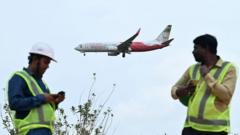Article Text:
Are India's skies safe? It's a pressing question following the tragic Air India crash in June that resulted in the loss of at least 270 lives. The Boeing 787-8 Dreamliner crashed shortly after departing from Ahmedabad, creating urgency around the topic of air safety in the nation.
Addressing these concerns, Faiz Ahmed Kidwai, the chief of the Directorate General of Civil Aviation (DGCA), emphasized in a BBC interview that India's aviation record has historically been strong. "For context, when examining global safety metrics, particularly those from the International Civil Aviation Organization (ICAO), India continuously outperforms the world average," he highlighted. "Only two years in the 2010–2024 period showed incidents beyond the global threshold, coinciding with significant accidents."
India's aviation history includes sobering incidents like the Air India Express Flight 1344 in August 2020, which ended in tragedy after skidding off a wet runway, claiming 21 lives, and the 2010 Mangalore crash that killed 158. Notwithstanding these major accidents, growing turbulence-related incidents and maintenance shortcomings have resurfaced safety as a highlight for scrutiny.
Among the concerns, SpiceJet, notable for its low-cost services, faced an investigation after mechanical failures were raised, prompting intervention from the aviation regulator. Dowty Propellers unearthed premature failures in the propellers of SpiceJet's De Havilland Q400 planes—a situation exacerbated by inadequate remediation actions from the airline management. Kidwai confirmed that corrective recommendations were made known and enforced.
The DGCA recently dealt with Air India Express, which faced repercussions for prolonging mandatory part replacements on its aircraft. "Acknowledging errors and self-reporting is pivotal," Kidwai conveyed, asserting value in transparency within the aviation sector.
Incidents like severe turbulence faced by an IndiGo flight highlighted renewed training needs for pilots navigating hazardous conditions—an evolution in guidelines is already in motion.
Despite the significant increase in air travel and a rise in reported technical faults, with airlines documenting over 2,460 issues since 2020, the DGCA remains optimistic that increased reporting indicates a growing safety culture.
India now ranks as the third-largest airline sector globally, with passenger numbers soaring from 116 million in 2014–15 to 239 million today. The expansion of operational aircraft and the number of aerodromes speaks to this rapid growth.
Nonetheless, Kidwai relayed that the recent crash has not profoundly impacted flight traffic. "Post-incident data indicates a negligible decline in air travel, which normalized quickly," he said. While it's natural for anxiety to arise after accidents, time typically alleviates such fears as public understanding improves.
As India navigates through rising passenger numbers and expanding aviation operations, the DGCA's vigilance remains essential in maintaining air safety and generating public confidence in travel.
Are India's skies safe? It's a pressing question following the tragic Air India crash in June that resulted in the loss of at least 270 lives. The Boeing 787-8 Dreamliner crashed shortly after departing from Ahmedabad, creating urgency around the topic of air safety in the nation.
Addressing these concerns, Faiz Ahmed Kidwai, the chief of the Directorate General of Civil Aviation (DGCA), emphasized in a BBC interview that India's aviation record has historically been strong. "For context, when examining global safety metrics, particularly those from the International Civil Aviation Organization (ICAO), India continuously outperforms the world average," he highlighted. "Only two years in the 2010–2024 period showed incidents beyond the global threshold, coinciding with significant accidents."
India's aviation history includes sobering incidents like the Air India Express Flight 1344 in August 2020, which ended in tragedy after skidding off a wet runway, claiming 21 lives, and the 2010 Mangalore crash that killed 158. Notwithstanding these major accidents, growing turbulence-related incidents and maintenance shortcomings have resurfaced safety as a highlight for scrutiny.
Among the concerns, SpiceJet, notable for its low-cost services, faced an investigation after mechanical failures were raised, prompting intervention from the aviation regulator. Dowty Propellers unearthed premature failures in the propellers of SpiceJet's De Havilland Q400 planes—a situation exacerbated by inadequate remediation actions from the airline management. Kidwai confirmed that corrective recommendations were made known and enforced.
The DGCA recently dealt with Air India Express, which faced repercussions for prolonging mandatory part replacements on its aircraft. "Acknowledging errors and self-reporting is pivotal," Kidwai conveyed, asserting value in transparency within the aviation sector.
Incidents like severe turbulence faced by an IndiGo flight highlighted renewed training needs for pilots navigating hazardous conditions—an evolution in guidelines is already in motion.
Despite the significant increase in air travel and a rise in reported technical faults, with airlines documenting over 2,460 issues since 2020, the DGCA remains optimistic that increased reporting indicates a growing safety culture.
India now ranks as the third-largest airline sector globally, with passenger numbers soaring from 116 million in 2014–15 to 239 million today. The expansion of operational aircraft and the number of aerodromes speaks to this rapid growth.
Nonetheless, Kidwai relayed that the recent crash has not profoundly impacted flight traffic. "Post-incident data indicates a negligible decline in air travel, which normalized quickly," he said. While it's natural for anxiety to arise after accidents, time typically alleviates such fears as public understanding improves.
As India navigates through rising passenger numbers and expanding aviation operations, the DGCA's vigilance remains essential in maintaining air safety and generating public confidence in travel.




















